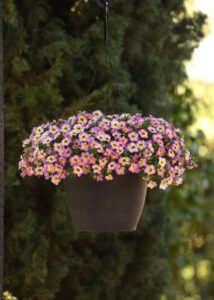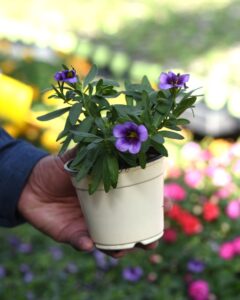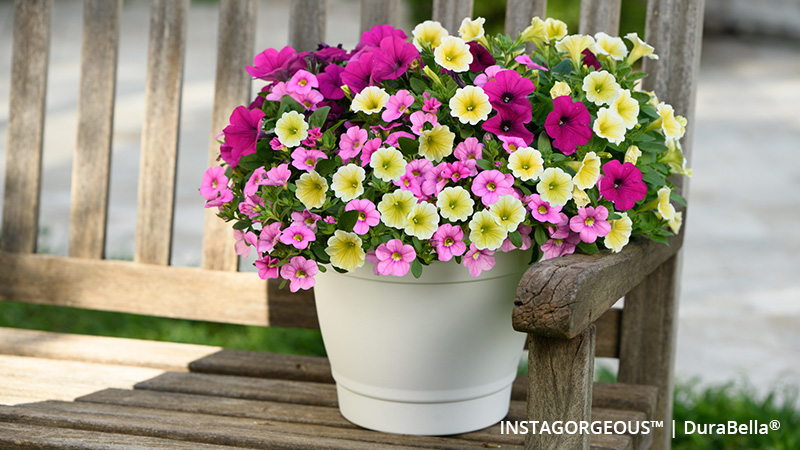Common Pitfalls to Avoid When Finishing Calibrachoa

Ball FloraPlant offers Calibrachoa ‘Cha Cha Diva Hot Pink.’ Photos: Ball FloraPlant
Calibrachoa, whether in mono hanging baskets or as a component plant in mixed containers, can really make registers ring in the garden center. But first growers must get it there — and looking good. Common production pitfalls in this class can lead to increased shrink, decreased profits, and are generally best avoided. In this article, we’ll tackle several of these challenges to help you have a successful calibrachoa season. Nutrition is the most common and easiest issue to address. With a container or basket crop time ranging from eight to 10 weeks, knowing how your fertilizer program will interact with your water source and media choice can help you schedule additional iron or micro-nutrient applications to optimize growth.
Be sure to monitor larger containers or longer crop time varieties for swings in pH. Often nutrient deficiencies showing on the plants are caused by a drift in the pH upwards and not due to low electrical conductivity (EC). If using a calcium nitrate-based fertilizer program in finish, pH will slowly creep up, and pH-driven nutrient issues can be remedied by injecting acid along with the feed, or by planting into a low pH mix. Municipal water sources typically run on the high pH side and require constant acid injection or the use of an ammonium sulfate-based fertilizer program to avoid high pH nutrient deficiencies.
Plant Growth Regulators: Take Care with Bloom Patterns
Calibrachoa provide a wide range of colors and patterns to attract consumers of all types. With these newer multicolor patterns, plant growth regulator (PGR) usage in finish can dramatically influence the stability of these patterns. Avoid spraying any PGRs on developing or open flowers unless otherwise tested previously. Never assume a color is in the same series you have grown previously or that both colors will respond the same to a PGR spray. If there is a negative interaction, a multicolored flower turns solid; a bright color becomes muddied and unattractive. It is better to sacrifice a few pots to know how PGR sprays will affect pattern stability than make a whole crop unsellable right before it ships.
PGR drenches in the finishing stage continue to be the safest PGR application from a pattern stability standpoint. However, they have their own risks, like the chance for overapplication. Avoid applying drenches with equipment you are unsure of. In a perfect world, you’ve checked your injectors to ensure they are calibrated correctly at the beginning of the season. While calculations can be incorrect, it’s more common that over-regulated plants are the result of malfunctioning application equipment.

Avoid spraying any PGRs on developing or open flowers.
Pests and Disease: Stay on the Alert
Diseases and pests are an ongoing challenge with calibrachoa production. Powdery mildew on calibrachoa has become an issue on the rise across North America. Preventative action is recommended, as with any mildew. In areas of high risk, a spray rotation should be applied as the canopy closes in and prior to hanging. If a preventative can’t be applied while growing, consider an application to prop trays prior to transplant.
Dry-down induced pythium is common in hanging basket production. Often a grower misjudges how much water is transpiring on a clear breezy day, and plants are flagging during morning rounds. If full-bloom plants ever moderately wilt, plan on a pythium drench in the next, approximately, three days. Roots could still experience injury from the EC media spike associated with the dry down.
Thrips and aphids tend to be the most common pests in finished production. Biological programs in areas where thrips tend to be an issue are adequate; scheduled applications of nematodes and predatory mites do well to keep populations low to tolerable. Under the right temperature and humidity environment, predatory mite sachets can provide weeks of control.
Even with chemical preventive programs, nematode media applications on larger pot sizes can assist in lowering populations. Before applying any nematodes, always check to see if you should remove filters to injectors and irrigation equipment for proper application. If using more traditional chemical integrated pest management (IPM) practices for thrips control, time your sprays prior to touches of the finished container. For example, ideal timing would be after transplant, prior to or after spacing, or prior to hanging. Always work in an insect growth regulator (IGR), as part of a tank mix or in your rotation, to attack additional life stages of thrips.
Most aphid infestations are discovered when crops are being pulled for shipping, and by then it’s better to pull from another location while the problem is dealt with. Routine preventive drench applications on baskets and containers do well to keep aphid populations low. Plan out your applications for the season and scout for hot spots if adjustments are needed. As echoes and driplines run, growers should spot-scout the crop for signs of instars shedding or “snow” on the foliage.
Banker plants and predatory wasps do work in closed environment situations. If baskets are hanging over a crop on the ground found to have aphids, remember to scout and possibly treat the baskets as well. Unless winged, aphids tend to be lazy passive pests, as they will be more localized within a crop versus throughout the whole crop.
By avoiding and/or tackling these common calibrachoa production pitfalls, growers can impress customers, wow shoppers, and (with some luck) amaze their accountants.









